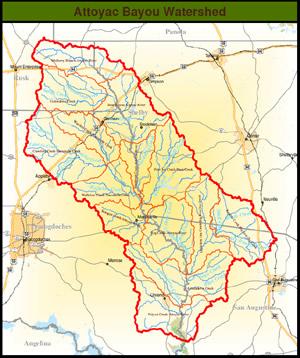 June 15, 2017 - Elevated levels of bacteria prompted the Texas Commission on Environmental Quality (TCEQ) to add Attoyac Bayou to the Texas 303(d) List of impaired waters in 2004. The Texas State Soil and Water Conservation Board (TSSWCB) partnered with the Nacogdoches Soil and Water Conservation District (SWCD), Texas Water Resources Institute (TWRI) and the Attoyac Bayou Watershed Partnership to develop a watershed protection plan (WPP) with the primary goal of improving water quality in the Attoyac Bayou through the implementation of management measures.
June 15, 2017 - Elevated levels of bacteria prompted the Texas Commission on Environmental Quality (TCEQ) to add Attoyac Bayou to the Texas 303(d) List of impaired waters in 2004. The Texas State Soil and Water Conservation Board (TSSWCB) partnered with the Nacogdoches Soil and Water Conservation District (SWCD), Texas Water Resources Institute (TWRI) and the Attoyac Bayou Watershed Partnership to develop a watershed protection plan (WPP) with the primary goal of improving water quality in the Attoyac Bayou through the implementation of management measures.
The Nacogdoches SWCD partnered with the TSSWCB through a Clean Water Act Section 319(h) grant to provide technical and financial assistance to producers in the watershed for the development and implementation of Water Quality Management Plans (WQMP).
A WQMP is a site-specific plan developed through and approved by SWCDs which includes appropriate land treatment practices, production practices, management measures, and technologies that prevent and abate agricultural and silvicultural nonpoint source pollution. The Nacogdoches SWCD, TSSWCB, and the USDA Natural Resources Conservation Service (NRCS) will assist agricultural producers in acquiring a WQMP and applying for and obtaining financial aid to implement best management practices (BMP). Landowners in the watershed are eligible to receive a maximum financial incentive amount of $15,000. The maximum financial incentive rate shall not exceed 60% of the cost of implementation of the BMPs. The remaining 40% will be provided by the landowner. Financial incentives will be based on actual costs not to exceed the average cost of the practice.
Chris Crenshaw was hired by the Nacogdoches SWCD as a district technician for the Attoyac Bayou watershed. Chris is available to help producers interested in learning more about the WQMP Program. Please feel free to contact Chris Crenshaw with any questions at 936-564-5891 Ext. 121 or Chris.Crenshaw@tx.nacdnet.net.
Examples of Best Management Practices Available for Implementation
- Water Well: This practice is to provide access to a groundwater supply suitable for livestock watering, fire control, wildlife, and other agricultural uses. This practice applies to all types of agricultural land where the quality and quantity of underground water is appropriate for the intended purpose. Does not apply to wells constructed solely for domestic or public water supply.
- Pipeline (livestock only): This practice may be applied as part of a resource management system to achieve one or more of the following purposes: convey water to points of use for livestock or wildlife, reduce energy use, or develop renewable energy systems. This standard applies to the conveyance of water through a closed conduit, from a source of supply to a watering facility, for use by livestock or wildlife. Does not apply to the use of pipelines for irrigation.
- Fencing (cross fencing only): This practice facilitates the accomplishment of conservation objectives by providing a means to control movement of animals and people, including vehicles. This practice may be applied on any area where management of animal or human movement is needed.
- Pasture Planting: Establishing adapted and/or compactible species, varieties, or cultivars or herbaceous species suitable for pasture, hay, or biomass production. Purposes include: to improve or maintain livestock nutrition and/or health, provide or increase forage supply during periods of low forage production, reduce soil erosion, improve soil and water quality, and produce feedstock for biofuel or energy production.
- Pond: This practice is to provide water for livestock, fish and wildlife, recreation, fire control, and other related uses, and to maintain or improve water quality. NRCS lists a standard which establishes the minimum acceptable quality for the design and construction of low-hazard ponds.
- Waste Storage Facility: This practice is used to temporarily store wastes such as manure, wastewater, and contaminated runoff as a storage function component of an agricultural waste management system.
- Brush Management: This practice is the management or removal of woody (non-herbaceous or succulent) plants including those that are invasive and noxious. Purposes include: create the desired plant community consistent with the ecological site. Restore/release desired vegetative cover to protect soils, control erosion, reduce sediment, improve water quality or enhance stream flow. Maintain, modify, or enhance fish and wildlife habitat. Improve forage accessibility, quality and quantity for livestock and wildlife. Manage fuel loads to achieve desired conditions. This practice can be applied on all lands except active cropland where the removal, reduction, or manipulation of woody plants in desired.
Funding for this effort is provided by a Clean Water Act Section 319(h) Grant from the Texas State Soil and Water Conservation Board and the US Environmental Protection Agency.









